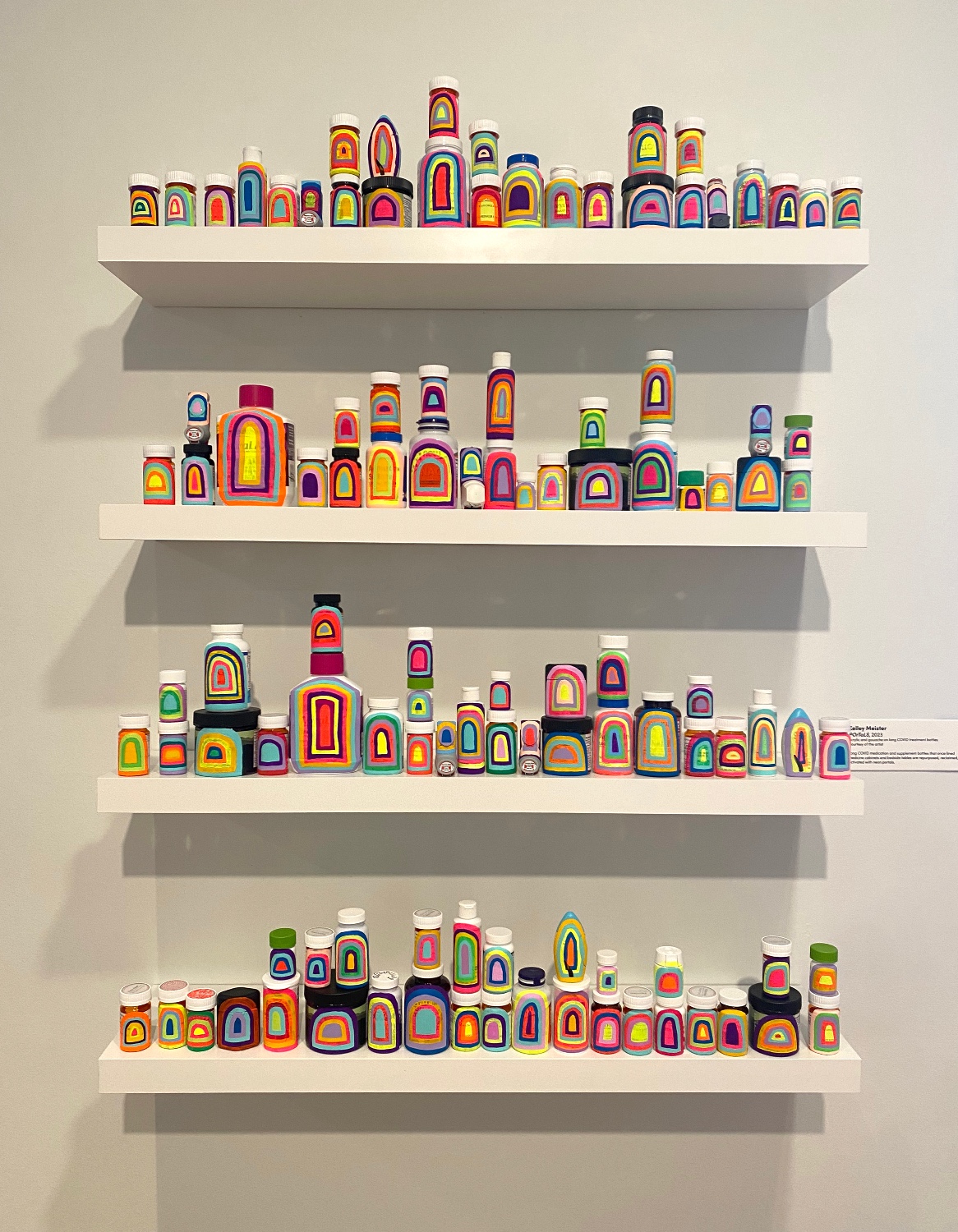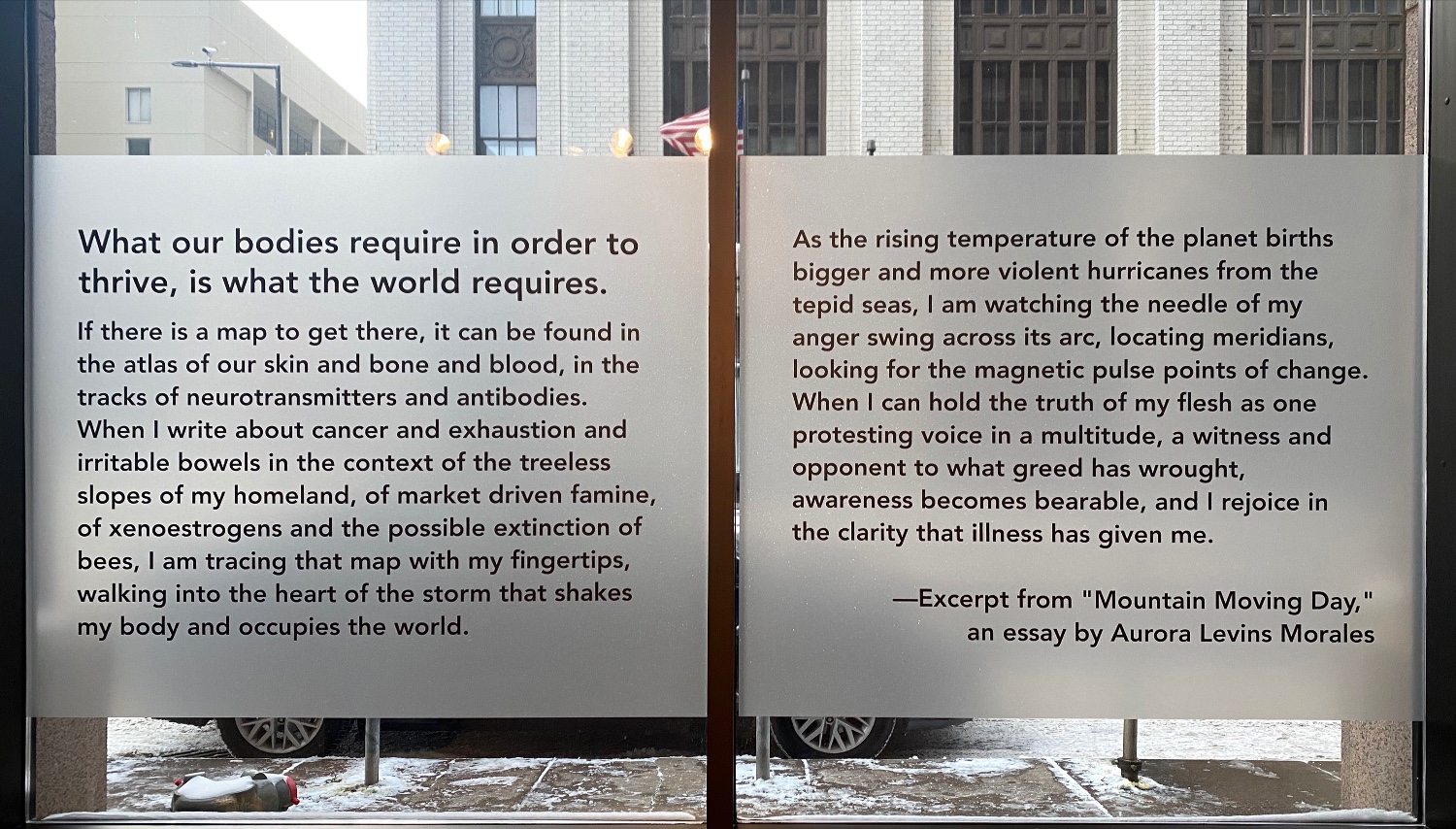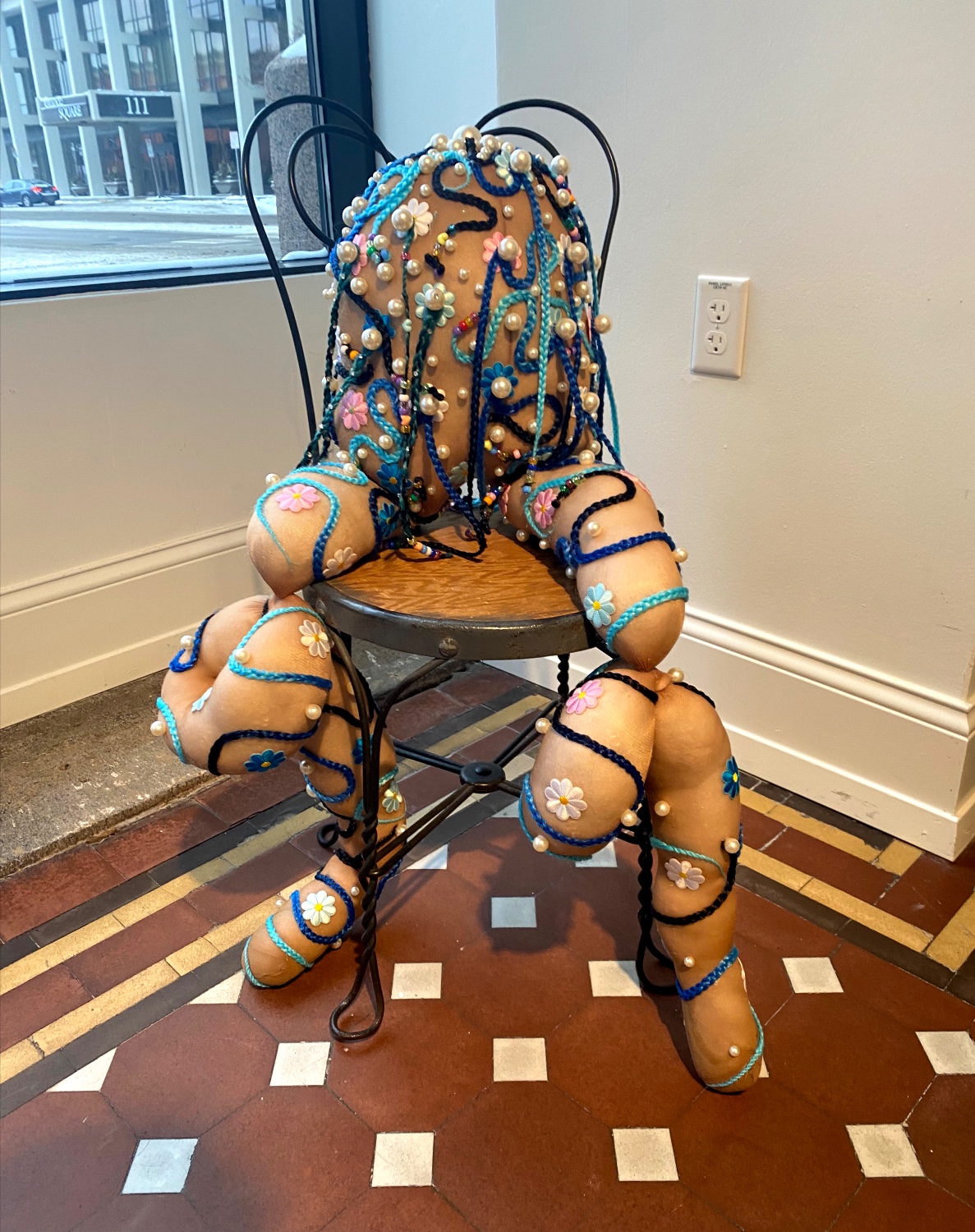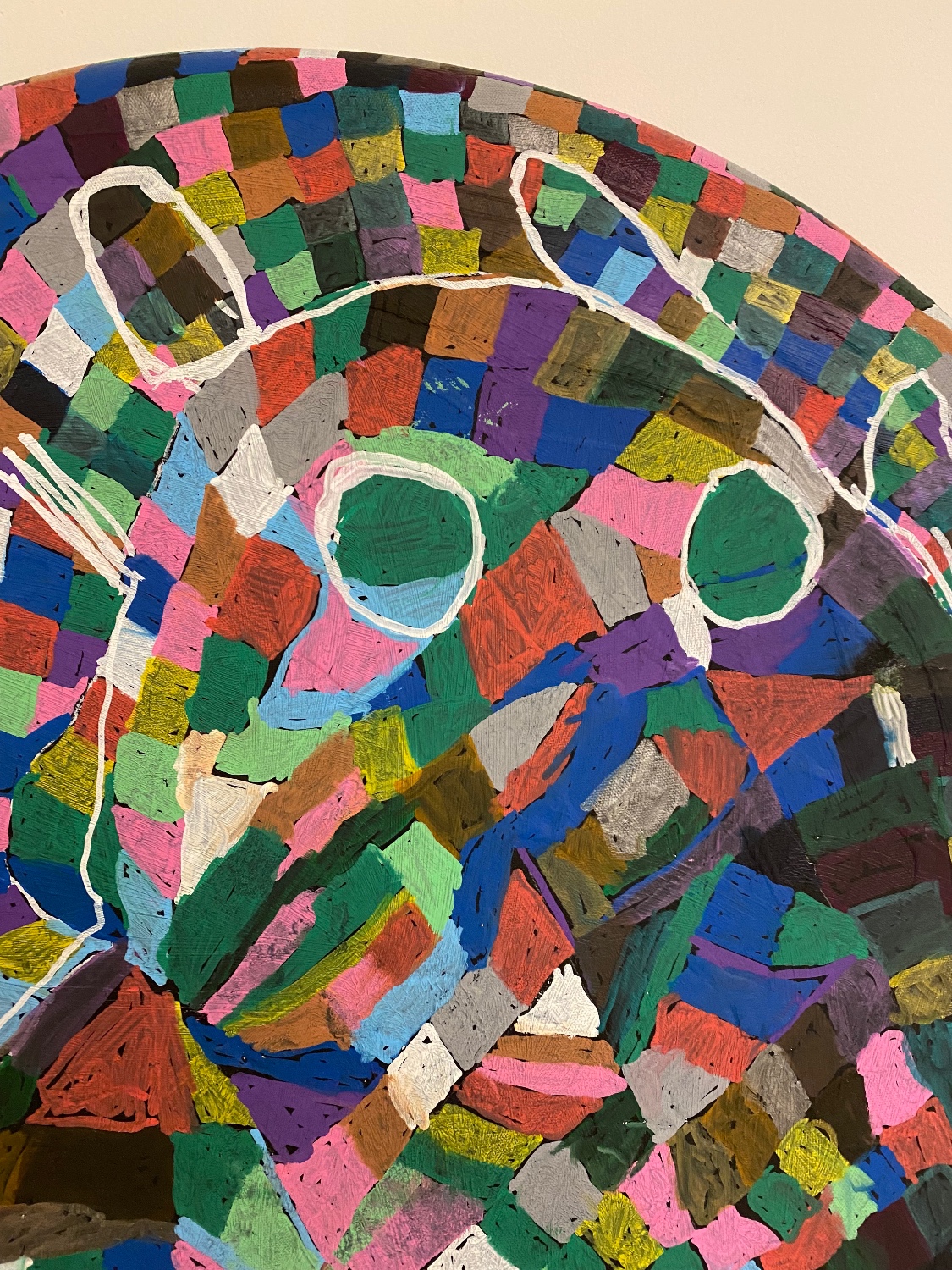
On Portals & Perfection: 'Currents' at the M
Published January 16th, 2024 by Benjamin Merritt
The group exhibition, curated by ECI Fellow Drew Maude-Griffin, offers critical and joyful work by five disabled artists
Currents, on view at the Minnesota Museum of American Art in Saint Paul, is a five-person exhibition that “references the strength, influence, and adaptability of disabled people and our communities.” Curated by Drew Maude-Griffin for their Emerging Curators Institute Fellowship, the exhibition features a variety of work in tone, content, and medium that all strongly showcase the lived experiences and vital creativity of disabled artists, including Victoria Dugger, Ariella Granados, Aurora Levins Morales, Kelley Meister, and Lynda Mullan. The artists’ works in the exhibition all play with scale and relationships — from the macrocosm of predatory capitalism to the smallest moments of inner thought to distract from physical pain, from prescription pills to a robotic pet. The exhibition “guide(s) us forward through the present, and inevitably toward futures that prioritize and embrace all the complexities and joys of radical access and care” by highlighting the importance of these webs of relationships and the impact they have on an individual scale as well as a communal scale.
Immediately outside of the gallery, the first pieces on view are two circular paintings by Lynda Mullan. The paintings are abstract, geometric fields of color that build a sense of depth and form through the interaction of tone and shape. On the left is a bright, largely yellow painting titled Torie; on the right is a darker painting with the rough outline of a cat in white titled Eddie. Lynda Mullan is an artist at Fresh Eye Arts, and Eddie is Lynda’s current pet, a robotic cat who stays alongside Lynda at every given moment. Eddie is a companion to Lynda and an extension of herself, and her paintings celebrate his companionship and the joy it brings her. The paintings’ color and interaction of form is vibrant and exciting; her compositions radiate a feeling of joy in the pure pleasure of color.

 All photos by Benjamin Merritt. Top: Lynda Mullan, Torie, 2021. Acrylic on canvas. Bottom: Kelley Meister, POrTaLS, 2023. Acrylic and gouache on long COVID treatment bottles.
All photos by Benjamin Merritt. Top: Lynda Mullan, Torie, 2021. Acrylic on canvas. Bottom: Kelley Meister, POrTaLS, 2023. Acrylic and gouache on long COVID treatment bottles.
Entering the gallery space, three more of Mullan’s paintings are hung next to a four shelf installation of painted medicine bottles. Visually echoing Mullan’s use of color, POrTaLS by Kelley Meister consists of bright, neon “portals” painted on medication and supplement bottles used for the treatment of Long COVID. I’m drawn to the way this piece plays with a simple gesture — painting on old medicine bottles — to bring the viewer into a relationship with the spatiality of disability. Are these portals entrances or exits? Doctors and pharmaceutical companies like to advertise certain medications as exits from disability, like it’s a room you can leave and lock the door to. But Long COVID — and chronic illness in general — is a room you may leave briefly but a room to which you will always return. These portals and the large number of them speak to that unending stay in the room, as if one portal leads to the next, and so on, in an infinite loop.
Adjacent to POrTaLS is an inkjet photo print and excerpt from a piece of writing by Aurora Levins Morales. The text excerpt also speaks to scale and relationships: “What our bodies require to thrive, is what the world requires. If there is a map to get there, it can be found in the atlas of our skin and bone and blood, in the tracks of neurotransmitters and antibodies.” Our relationship with our bodies mirrors our relationship with the world around us. Just as the climate crisis creates storms that swell and break due to the abuse via capitalist greed, our bodies swell and break too. Health crises across the globe are active byproducts of the treatment of the earth and the destruction, pollution, and exploitation by the ruling classes. Disability is disability because the structures that we live in do not and will not accommodate other modes of existence. This is the social model of disability, which argues that structural barriers and lack of care are the disabling factors in life, not particular embodiments, conditions, or ways of being. Next to Morales’s print and writing is a piece that expands on this in a heartfelt and intimate way.
Ariella Granados’s Disabling Utopia is a series of inkjet photographic prints and a short film that build on the idea of “utopia” in the context of disability. These photos showcase other disabled artists dressed in vibrant costumes in surreal environments. There are multiple versions of them in the photos: two or three variations of self in different poses or performing different gestures. This multiplicity mirrors the multiplicity that comes with disability and illness, in the different versions of ourselves that exist in different situations due to pain levels, access, or simply who you are around. In the context of the social model of disability, too, I think about the multiplicity of selves and the possibility of identity that could be fostered if we lived in a more accessible world. I think about all the wonderful people who are unable to do things they love or be around the people they care about because of the disabling social structures that they have been put into. These photos also are extremely vibrant and colorful, just as the rest of the work in the exhibition, emphasizing the idea of joy and vitality throughout the entire show.

 Top: Excerpt from "Mountain Moving Day," an essay by Aurora Levins Morales. Bottom: Victoria Dugger, The Miseducation of an Oyster, 2020. Nylon, ink, pearls, and hair.
Top: Excerpt from "Mountain Moving Day," an essay by Aurora Levins Morales. Bottom: Victoria Dugger, The Miseducation of an Oyster, 2020. Nylon, ink, pearls, and hair.
Placed in various locations on the floor in the gallery space are sculptural pieces by Victoria Dugger. The most explicitly corporeal pieces in the exhibition, these sculptures combine bodily adornment with the grotesque, the abstracted raw human body in strange poses and glimpses of the abject. The sculptures are relaxed, sitting on decorative chairs and covered in pearls, butterflies, flowers, and beads. There is a confidence and a beauty to these objects, with the traditionally”‘grotesque” parts of the body being emphasized and celebrated with adornment. This is a key aspect of true access: the ability for people to not have to hide anything about their body in fear of being unwelcome.
One of the artists in Granados’s short films talks about perfection in chaos. They talk about the idea of utopia and perfection as an acknowledgement and acceptance of imperfection and not the elimination of them. All of the work in Currents echoes this sentiment, suggesting that the web of relationships we build within our communities are the building blocks of a utopia for us to live in — whether that be helping someone find the right medication for their new symptoms, the time we spend with a robotic pet cat, or navigating our way through a global climate and health crisis. All of the work in this exhibition feels powerfully joyful or confident in its reality; there is no sense of hopelessness or despair that typical curators would assign to a show about Disability. When I leave the gallery after spending time with all of this work, I am greeted again by the two paintings by Lynda Mullan at the entrance. The brighter piece feels like a portal or a spiral, an invitation to get lost in the possibility of the future, looking forward with the guidance of the artists in Currents. ◼︎
 Detail of Lynda Mullan's Eddie, 2022. Acrylic on canvas.
Detail of Lynda Mullan's Eddie, 2022. Acrylic on canvas.
Currents is on view at the M through February 25. Museum hours are Thursday through Sunday, 10am – 4pm. For more, visit mmaa.org or follow them on Instagram @mnmuseum.
Banner image: Ariella Granados, Disabling Utopia: Adri (detail), 2023. Photograph.
This activity is made possible by the voters of Minnesota through a grant from the Metropolitan Regional Arts Council, thanks to a legislative appropriation from the arts and cultural heritage fund. 
We can't do it without you.
Help keep independent arts journalism alive in the Twin Cities.
We can't do it without you.
Help keep independent arts journalism alive in the Twin Cities.